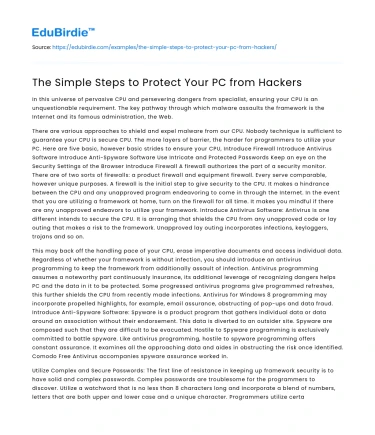Introduction
In the contemporary digital landscape, the prevalence of cyber threats poses significant risks to personal and organizational computers. As technology evolves, so do the tactics employed by hackers to infiltrate systems and extract sensitive information. This essay explores the imperative steps individuals can take to protect their computers from unauthorized access and malicious activities. Emphasizing the importance of proactive measures, this discussion highlights the fundamental strategies that can fortify a computer's defenses against potential cyber attacks. According to a study by Cybersecurity Ventures, cybercrime is predicted to cost the world $10.5 trillion annually by 2025, underscoring the urgency of implementing robust security protocols (Morgan, 2021). This essay argues that while no system is entirely impervious to hacking, adopting a comprehensive, layered approach can significantly mitigate the risks and enhance overall security.
Implementing Robust Security Software
The first and most crucial step in protecting a computer from hackers is the use of comprehensive security software. Antivirus programs, firewalls, and anti-malware tools form the backbone of a computer's defense system. These tools detect, prevent, and remove malicious software that can compromise a system's integrity. According to Symantec, a leading cybersecurity firm, antivirus software can stop up to 99% of known threats, providing a critical line of defense against cyber attacks (Symantec, 2020). However, it is vital to regularly update these programs to ensure they can combat the latest threats, as hackers continuously develop new techniques to bypass outdated security measures.
Save your time!
We can take care of your essay
- Proper editing and formatting
- Free revision, title page, and bibliography
- Flexible prices and money-back guarantee
Moreover, utilizing a firewall is essential for monitoring and controlling incoming and outgoing network traffic. Firewalls act as a barrier between trusted and untrusted networks, effectively blocking unauthorized access. By configuring firewalls to specific security needs, users can tailor the level of protection according to their requirements. A report by Gartner emphasized that organizations using advanced firewall solutions reduced their risk of data breaches by 40% (Gartner, 2021). Thus, integrating robust security software not only protects individual systems but also contributes to the overall security infrastructure of an organization.
Transitioning from the significance of security software, it is equally important to consider the role of system updates and patches. Regular updates ensure that software vulnerabilities are addressed promptly, minimizing exposure to potential exploits. In the following section, the focus will shift to the importance of maintaining up-to-date software to safeguard against newly discovered threats.
Regular Software Updates and Patching
Keeping software up to date is a critical component in defending against cyber threats. Software developers frequently release updates and patches to fix security vulnerabilities that hackers could exploit. The notorious WannaCry ransomware attack in 2017, which affected over 200,000 computers worldwide, highlighted the consequences of neglecting software updates. Many of the affected systems were running outdated versions of Microsoft Windows, which had a known vulnerability that could have been patched months before the attack (Greenberg, 2017). This incident underscores the necessity of timely updates as a preventive measure against cyber attacks.
Operating systems, applications, and even hardware components should be regularly updated to ensure the latest security enhancements are in place. Automated update settings can assist users in keeping their systems current without requiring manual intervention. As a counter-argument, some users may express concerns about the potential for updates to disrupt workflow or cause compatibility issues. However, the benefits of maintaining updated software far outweigh the temporary inconveniences. By prioritizing updates, users can significantly reduce the risk of cyber threats and maintain system integrity.
Transitioning to the next line of defense, the essay will explore the importance of strong password practices. Passwords serve as the first line of defense against unauthorized access, and developing secure password habits is essential for comprehensive computer protection.
Establishing Strong Password Practices
Passwords are often the first barrier between a hacker and a computer system. Despite their importance, weak passwords remain a common vulnerability. According to a report by Verizon, 81% of hacking-related breaches leveraged either stolen or weak passwords (Verizon, 2020). To combat this, users should employ complex passwords that combine letters, numbers, and symbols, and avoid using easily guessed information such as birthdays or common words.
Implementing multi-factor authentication (MFA) adds an additional layer of security by requiring users to provide two or more verification factors to gain access. This can include something the user knows (a password), something the user has (a security token), or something the user is (biometric verification). MFA significantly reduces the risk of unauthorized access, even if a password is compromised. A study by Microsoft found that accounts using MFA are 99.9% less likely to be compromised (Microsoft, 2019).
While some argue that MFA can be inconvenient, the enhanced security it provides is invaluable. As the complexity of cyber threats continues to grow, robust password practices and the implementation of MFA are essential steps in protecting against unauthorized access. In the concluding section, the essay will synthesize the discussed strategies and reinforce the importance of a proactive approach to cybersecurity.
Conclusion
In conclusion, as cyber threats become increasingly sophisticated, safeguarding computers from hackers requires a multi-faceted approach. Implementing robust security software, ensuring regular software updates, and establishing strong password practices are fundamental steps that significantly enhance a computer's defense against unauthorized access. While no single measure can guarantee complete protection, combining these strategies creates a formidable barrier against potential threats. As technology continues to evolve, so must the methods employed to protect it. By staying informed and proactive, individuals and organizations can effectively mitigate risks and secure their digital assets. As cybersecurity expert Bruce Schneier aptly stated, "Security is a process, not a product," emphasizing the ongoing commitment required to maintain robust computer security (Schneier, 2011).






 Stuck on your essay?
Stuck on your essay?

